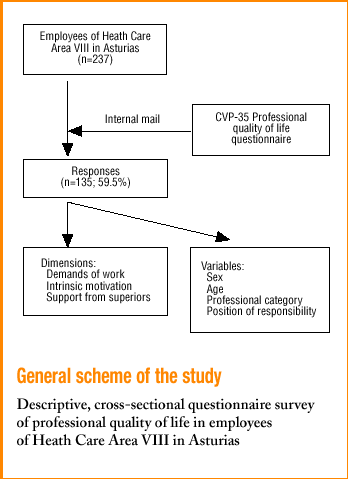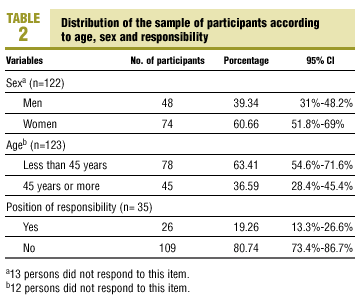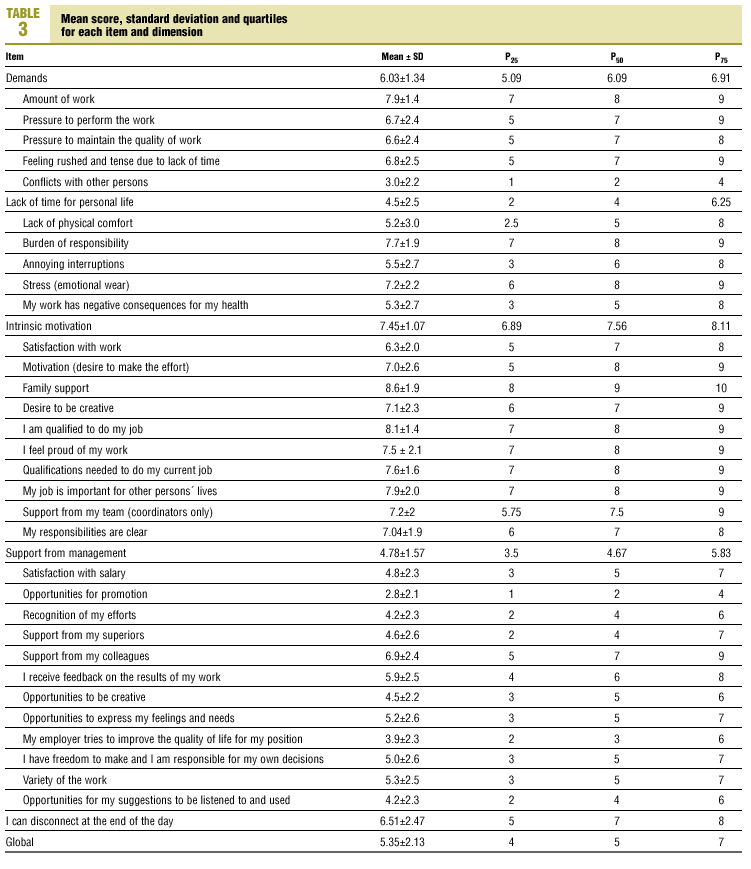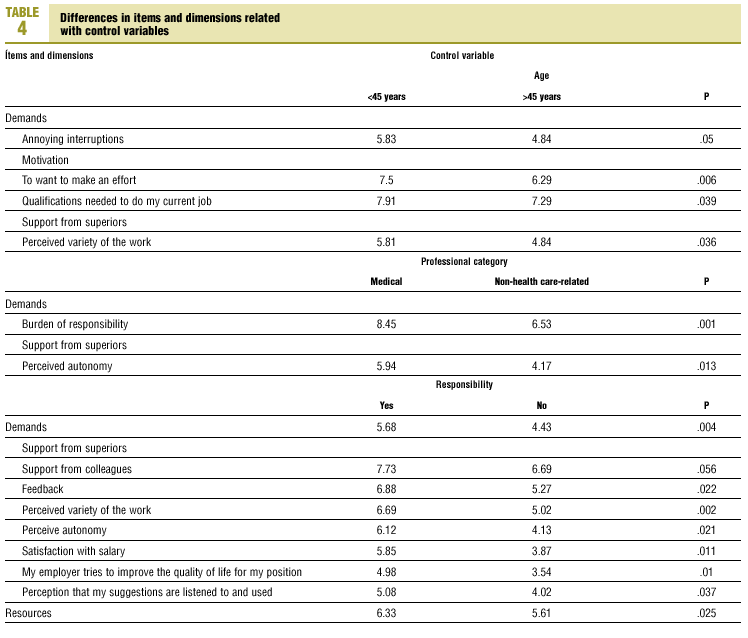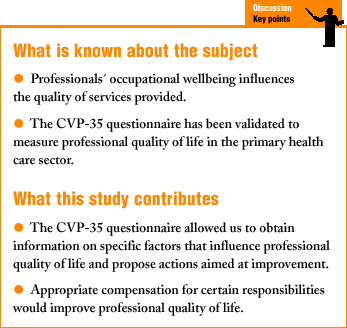(7,34-7,56). Conclusiones. Los profesionales del Área Sanitaria VIII de Asturias tienen una percepción media de su calidad de vida profesional, perciben que los directivos les dan un apoyo medio y que tienen una elevada motivación intrínseca para afrontar unas demandas altas en sus puestos de trabajo.
Introduction
Within the health administration, interest in the quality of the services provided and the degree of patient satisfaction is high.1,2 Employee satisfaction and quality of life have been less frequently studied, even though occupational wellbeing influences how effectively employees work.3-5
Many years have passed since Donabedian6 first demonstrated the relationship between professionals´ expectations and service quality; this author considered physicians´ satisfaction to be a causal factor of good health care. However, it has only been in recent years that interest has awakened in determining professionals´ satisfaction and perceived quality of life.7-11
García Sánchez defined professionals´ quality of life as the experience of wellbeing derived from the balance the individual perceives between demands or the burden of challenging, intense or complex work and the resources (psychological, organizational and relational) available to cope with demands. Professional quality of life thus depends13-15 on a number of factors, some personal (age, sex, personality), some family-related (marital status, family support), some strictly employment-related (compensation, professional career). Because these factors are the same throughout the organization, they can be modified only by changes that are dependent on decisions made by superiors. In addition, some factors are related to professional recognition, working conditions and management style; within the setting of health care management, these factors can be modified in the short and middle term.
The aim of the present study was to determine the perceived quality of life in professionals employed in Health Care Area VIII in Asturias (northwestern Spain), in order to propose specific measures for improvement.
Methods
This cross-sectional study was done as part of the strategic plan for Area VIII of the primary health care system in Asturias. This area serves a population of 88 000 inhabitants and employs 80 staff physicians, 81 non-physician health care staff and 76 non-medical, non-heath care-related staff members.
To evaluate the workplace climate we used a 35-item professional quality of life questionnaire (CVP-35) validated in 1995 for primary health care workers.15 This self-administered instrument provides anonymous information and has a Cronbach alpha of 0.84. Professional quality of life is defined as «the experience of wellbeing associated with the perception of balance between the demands imposed by work and the perceived capacity to cope with them.» The CVP-35 contains 35 closed items that measure three dimensions: work demands, intrinsic motivation and managerial support. The first dimension is measured by 11 items relating to the worker´s perception of workplace demands. Intrinsic motivation is covered in 10 items, and emotional support received from managerial staff is measured in 12 items. Two items examine overall quality of life and ability to disconnect at the end of the working day.
Each item is evaluated on a quantitative scale of 1 to 10; as an aid, the points on the scale are labeled «none» (0-2), «some» (3-5), «quite a lot» (6-8) and «a lot» (9-10).
We considered the possibility of including variables such as place of work, age of the center, and type of contract (permanent or temporary), but in order to guarantee anonymity we included as control variables only sex, age and professional category (physician, health care-related, non-health care-related, no response). We also recorded whether the participant held a position of responsibility (for example, medical coordinator, chief of nursing service, or team head of an administrative unit).
The questionnaire was sent by internal mail in June 2001 to all staff members, together with a cover letter requesting participation in the name of the Area Director. Completed questionnaires were to be sent by internal mail to the director´s office for tabulation and analysis with the Statistical Package for Social Sciences (SPSS-10). To increase the response rate the survey was remailed to all staff members together with a letter reminding them of the importance of responding.
For the statistical analysis, quantitative variables were reported as the mean, standard deviation and quartiles, and qualitative variables were reported as absolute and relative frequency distributions. Differences in the results for given items that were found to be related to the control variables were checked with nonparametric (Mann-Whitney U and Kruskal-Wallis) tests; the level of statistical significance was set at 0.05.
Results
A total of 237 questionnaires were sent, and 135 completed questionnaires were received, for a response rate of 59.5% (95% CI, 53.0%-65.7%). (Ten staff members who were sent the questionnaire while on sick leave or maternity leave were not taken into account in calculating the response rate.) Table 1 shows the percentage response rates for each professional category, and table 2 shows the respondent´ characteristics regarding age, sex and level of responsibility.
Table 3 records the means scores for each item. The global mean score was 5.35 (95% CI, 5.12-5.58). We note that 25% of all responses were scored as 4 or lower, and another 25% were scored as 7 or higher. The mean score for the dimension intrinsic motivation was high (7.45; 95% CI, 7.34-7.56), whereas workplace demands were judged moderately high (6.03; 95% CI, 5.89-6.17) and mean score for support from superiors approached 5 (4.8; 95% CI, 4.63-4.97). Table 3 also shows the mean results for each dimension, global professional quality of life, and ability to disconnect at the end of the day.
We found no statistically significant differences in the scores for any item on the basis of sex. Table 4 summarizes the differences found in relation with other control variables. Participants older than 45 years, and non-health care-related staff members, scored lower on some items, whereas persons in positions that involved managerial responsibility valued support from superiors more highly.
Discussion
The percent response rate was lower than in earlier studies,5,7 probably because the participants felt that the survey would not be useful in improving their professional quality of life. However, in these previous studies the questionnaires were collected through the office of the director of the center, a measure that may have helped improve the response rate. In any case, we believe the level of response in the present study was acceptable. Among physicians, the response rate in our study (67.1%) was higher than in an earlier survey in our autonomous community16 of occupational satisfaction and professional burn-out (61.3%).
Because the responses to the questionnaire were anonymous we were not able to investigate the causes of nonresponse. We cannot rule out selection bias, as we found statistically significant differences between the percentages of responders among health care-related staff and non-health care-related staff. The effect of this bias may have been to underestimate the differences between these two groups: less satisfied employees may have been less likely to respond.
A larger proportion of physicians responded than of the other two employee categories, as also noted in other studies of this type.7,8,15 This no doubt reflects their greater familiarity with such studies.
Of the individual items, the one that was scored highest was family support, and the lowest mean score was found for opportunities for promotion. Similar results were reported in an earlier study.4 However, unlike other authors, we did not find differences between categories of professionals,17,18 possibly because of the size of our sample. The only comparable studies we located were those published by the Catalonian Institute of Health.7,15 Galobart Roca and colleagues used an earlier version of the questionnaire, but studied only hospital staff members, which limits the extent to which the results of our study and theirs can be compared.
As in the studies mentioned above,7,15 the scores for most items were greater than 5 (neutral value), especially in items related with intrinsic motivation and family support.
In the perceived workplace demands dimension, professionals´ perception of a high degree of responsibility was noteworthy. This was directly proportional to the level of qualification and training, and was logically greater in persons who held positions of responsibility.
However, in contrast with earlier findings,19 we found no difference in perceived work demands between categories of professionals. Perceived demands are influenced not only by the actual workload, but also by job insecurity and uncertainties regarding specific responsibilities. As noted above, we felt it inappropriate to ask respondents to indicate whether they were on a permanent or temporary contract, although in our study area 46% of all employees are on temporary contracts.
All items relating to perceived intrinsic motivation scored above 5, a result we interpret as a high degree of intrinsic motivation in professionals whose resources to cope with work demands are grounded mainly on family support. Similar findings were reported by others.7,15
In the dimension perceived emotional support from superiors, a finding of note was that the score for feedback employees received about their work was higher in the setting we studied (5.9) than in the Ponent Primary Care Subdivision (3.7). Moreover, the score on this item was higher than the mean for the entire questionnaire. We consider these results encouraging. Periodic reports on progress toward goals are sent to staff teams, and technicians from the office of the director visit each center to inform the staff on the progress made.
Items on support from superiors (4.6 vs 4.9) and opportunities to express feelings and needs (5.2 vs 5.3) scored lower than in other studies.7,15 In the study sponsored by the Catalonian Institute of Health, nursing coordinators and adjuncts were considered to hold positions of responsibility7, in contrast to the present study. This might explain the small difference in the score for support from superiors.
Another factor that might account for these differences is the type of study: a cross-sectional evaluation of certain dimensions at one point in time. However, the questionnaire was shown to have good consistency in the validation study.15 Moreover, we were not able to repeat the survey in our setting within a relatively short period, as the same instrument was used to analyze the status of the strategic plan for our health care area.
The perception that opportunities to express feelings and needs were scarce contrasts with the large number of opportunities for participatory management (10 staff committees in our Health Care Area, with a total of 237 staff members). In 1998, all centers instituted a system of standardized incident report and suggestion forms designed expressly for the purpose of allowing employees to send suggestions and proposals for improvement to the office of the director. (In the previous three years, eight incident report forms and no suggestion forms were received.) This finding also contrasts with the high level of participation in working groups for special programs, and the high level of voluntary participation (23% of all staff) in the development of the strategic plan. We believe that these results reveal an internal communication problem that deserves further detailed analysis.
A number of studies have documented professionals´ need for greater recognition for their work.20 In our setting too, this item scored less than 5, as reported in the reference study. There appears to be a unanimous conviction regarding the benefits of formal, public recognition for one´s efforts and opportunities for professional career development.21-23
Among staff members in positions of responsibility, the perception of support from superiors and autonomy was greater, as was satisfaction with the salary, despite the fact that differences in salaries between coordinators or section heads and all other staff were not significant. This suggests that appropriate compensation for certain responsibilities would be expected to improve perceived professional quality of life.
Although nursing staff have been reported to be the least satisfied with their work,4,24 and women in one study perceived better professional quality of life than did men,19 we found no significant differences in overall professional quality of life in relation to professional category, age or sex.
The mean score for overall professional quality of life was 5.35 (of a maximum of 10). In 25% of the participants who responded to the questionnaire, the score for this item was 7 or higher, whereas another 25% scored this item as 4 or lower. Because differences between primary care teams in organizational procedures may be related with administrational differences between health centers, it would be useful to obtain detailed information on each team´s procedures. This would make it possible to evaluate professional quality of life for each service unit individually.
However, the fact that our findings are similar to those for other health care areas that have been tracking professional quality of life for several years15 leads us to ask, as did Clúa Espuny and Aguilar Martín,7 whether the CVP-35 actually measures professional quality of life perceived as a group of factors related with internal management and therefore potentially modifiable, or whether it measures the balance between work demands and the expectations of employees in a civil service system.
We conclude that primary care professionals in Health Care Area VIII in Asturias perceive an acceptable overall professional quality of life, perceive an intermediate degree of support from their superiors, and have a high degree of intrinsic motivation to cope with the large demands of their jobs.
Our findings show that the staff members we surveyed were concerned about the workload the are expected to deal with, and the degree of responsibility involved. Their view is that their employer´s interest in professional quality of life and opportunities for promotion are insufficient.
These results clearly raise possibilities for improving the workplace atmosphere in the health care area we studied. The information provided by the CVP-35 questionnaire is highly useful, and has led to specific interventions within the strategic plan for this area.25 There are plans for the questionnaire to be administered again at a later date to evaluate the changes brought about as a result of these interventions.
It should be recalled that professional quality of life is judged as the balance employees perceive between the characteristics of their job and their own wishes and expectations. Because of their dynamic nature, and because changes in them affect job satisfaction, further efforts should be devoted to characterizing these wishes and expectations in detail.
Correspondence: Margarita Alonso Fernández. C/ Ildefonso Sánchez del Río, 5, bajo. 33001 Oviedo. España. E-mail: margaraf@princast.es
Manuscript accepted for publication 6 March 2002.







